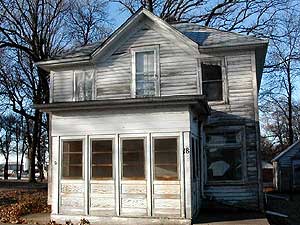The high cost of housing
January 27, 2003
 |
| This house in Elbow Lake is a rundown rental property. A non-profit agency plans to remodel the house and sell it to a low to moderate income family. (MPR Photo/Dan Gunderson) |
Moorhead, Minn. — In the past decade, the cost of housing increased twice as fast as wages. That widening gap keeps home ownership just beyond the reach of people like Dennis and Jodi Wheeler.
"What we live in today, we're surviving," says Dennis. "Things are tough and we would love something better."
Dennis, Jodi and their four children live in a 30-year-old trailer home in Frazee, Minnesota. Jake, 7, shares a single small bedroom with three siblings.
Dennis works full time as a boat mechanic, and Jodi works nights as a housekeeper. Both hold part-time jobs on the side. Their combined income is nearly $40,000 a year. The Wheelers bought a trailer about five years ago because they were tired of struggling to pay rent.
 | |||
Dennis tracks every penny they spend.
"Twenty percent of our income is going toward food. Another 20 percent goes to gas and automobile expenses. School is costing us six, seven percent," says Dennis. Jodi adds, "We're not getting ahead, we're getting by. Flat tire on the car, there goes the utility bill."
The Wheelers now spend about 15 percent of their income on housing. That's half the recommended maximum housing expense.
They're trying to pay off medical bills that piled up when they did not have health insurance. They don't use credit cards. Credit card debt is a large burden for many people who are working, but poor, in Minnesota.
For the Wheelers, living on the financial edge means it's impossible to save for a down payment on a house.
 | |||
Dennis watches the housing market in west central Minnesota. He says buying what's on the market would take at least 40 percent of their monthly income. "And there's no way I could see us affording that. We couldn't pay the utilities then," says Dennis.
"I know this one gal that was building a house last summer," Jodi adds. "She's working two jobs, and she's never home. I'm thinking, if you have to work two jobs to afford this really great house and you're never in it, what's the sense of buying a house? If you can't survive on eight or 10 hours, and sleep in your own bed, I don't know if I want a house."
The Wheelers want a fixer-upper, an older home that needs some work. But homes that need major repairs don't pass the inspections required by banks to qualify for a mortgage.
So the Wheelers find themselves trying to solve a financial puzzle that has missing pieces. A growing number of Minnesotans are in a similar quandary.
Nearly one in five Minnesota homeowners spends more than 30 percent of their income on housing. It's the same for one-third of renters. That means they don't have enough money to pay for necessities like food and health care.
 | |||
Most of the hundreds of millions of dollars spent each year to create affordable housing in Minnesota come from government programs. But studies show demand for affordable housing still far exceeds supply.
In many small towns, most people can't afford new homes. The affordable houses are old and often run down. Across Minnesota, thousands of homes are in need of major repairs.
John Pritschet runs a housing rehab program for West Central Minnesota Communities Action, based in Elbow Lake. On a cold winter morning, he's looking at a rundown two-story house built about 75 years ago.
Outside, the walls have little paint left on them. Inside, the carpet is dirty and torn, the walls are cheap paneling and cracked plaster. It's a solid old house, but it will need new wiring, new plumbing and a complete interior and exterior facelift. John Pritschet estimates the rehab will cost about $60,000.
"Is it worth sticking $60,000 into a house?" asks Pritschet. "But if you demolish it and put up a new house, the people that need it aren't going to be able to afford it, so they're still stuck in the same situation." This house will sell for between $50,000 and $60,000 when it's done. John Pritschet says it will likely be sold before the sawdust settles. This kind of break-even venture is something only a non-profit agency can accomplish.
 | |||
"(For) a private contractor it's tougher, because he's going to want to sell it for what he's got in it and make a profit," says Pritschet. "In our situation, we don't care. We're a non-profit organization, so our funding sources would rather see us fix a house and save a house like that."
But for each unit of affordable housing created across Minnesota, it's estimated three or four families are still waiting and hoping. State officials say Minnesota has made progress on affordable housing in recent years, but it's still a serious problem.
Rochelle Rubin works for the Minnesota Housing Finance Agency. She says affordable housing is an important part of a strong economy.
"We know families and communities do better, they're more stable, when safe affordable housing is available," says Rubin. "We know that in this area, government subsidies are never going to solve the whole problem."
Rubin says the state is trying to encourage private sector investment in affordable housing. She says one way to trim the cost of new housing is to reduce regulations. For example, if communities allowed higher-density housing developments, the construction cost per unit would be lower.
Other solutions are being tried around the state. In Rochester, a public-private land trust program will reduce the cost of a new home by as much as $30,000. And some communities offer temporary tax breaks for new homes.
But thousands of Minnesota families will continue to struggle to keep a roof over their heads.
|
News Headlines
|
Related Subjects
|

